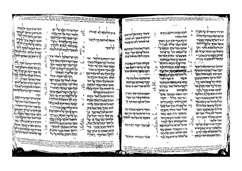Jeremiah 27
| Jeremiah 27 | |
|---|---|
|
Book of Jeremiah in Hebrew Bible, MS Sassoon 1053, images 283-315. | |
| Book | Book of Jeremiah |
| Bible part | Old Testament |
| Order in the Bible part | 24 |
| Category | Nevi'im |
Jeremiah 27 is the twenty-seventh chapter of the Book of Jeremiah in the Hebrew Bible or the Old Testament of the Christian Bible. It is numbered as Jeremiah 34 in Septuagint. This book contains the prophecies spoken by the prophet Jeremiah, and is a part of the Books of the Prophets.[1][2]
Text
- The original text is written in Hebrew language.
- This chapter is divided into 22 verses.
Textual versions
Some most ancient manuscripts containing this chapter in Hebrew language:
- Masoretic Text (10th century)
- Dead Sea Scrolls: (2nd century BC)[3][4]
- 4QJerc (4Q72): extant: verses 1‑3, 13‑15
Ancient translations in Koine Greek:
- Septuagint (3rd century BC; different verse numbering)
- Theodotion version (~AD 180)
Verse 1
- In the beginning of the reign of Jehoiakim the son of Josiah, king of Judah, this word came to Jeremiah from the Lord, saying (NKJV)[5]
Verse 16
- Also I spoke to the priests and to all this people, saying,
- “Thus says the Lord:
- ‘Do not listen to the words of your prophets who prophesy to you, saying,
- “Behold, the vessels of the Lord’s house will now shortly be brought back from Babylon”;
- for they prophesy a lie to you.’ (NKJV)[6]
Verse 22
- ‘They shall be carried to Babylon, and there they shall be until the day that I visit them,’
- says the Lord.
- ‘Then I will bring them up and restore them to this place.’ (NKJV)[7]
- The pillars of the temple, named Jachin and Boaz (1 King 7:15-22), the large copper basin called "the sea" (1 King 7:23-26), the stands and vessels (1 King 7:27-39) would be carried to Babylon in 586 BC, when Jerusalem fell, but the vessels were later returned intact by king Cyrus in 538-535 BC (Ezekiel 1:7-11).[8][9]
Verse numbering
The order of chapters and verses of the Book of Jeremiah in the English Bibles, Masoretic Text (Hebrew), and Vulgate (Latin), in some places differs from that in Septuagint (LXX, the Greek Bible used in the Eastern Orthodox Church and others) according to Rahlfs or Brenton. The following table is taken with minor adjustments from Brenton's Septuagint, page 971.[10]
The order of CATSS based on Alfred Rahlfs' Septuaginta (1935), differs in some details from Joseph Ziegler's critical edition (1957) in Göttingen LXX. Swete's Introduction mostly agrees with Rahlfs edition (=CATSS).[10]
| Hebrew, Vulgate, English | Rahlfs'LXX (CATSS) |
|---|---|
| 27:1,7,13,17,21 | none |
| 27:2-6,8-12,14-16,18-20,22 | 34:2-6,8-12,14-16,18-20,22 |
| 50:1-46 | 27:1-46 |
See also
Notes and references
- ↑ J. D. Davis. 1960. A Dictionary of The Bible. Grand Rapids, Michigan: Baker Book House.
- ↑ Therodore Hiebert, et.al. 1996. The New Interpreter's Bible: Volume: VI. Nashville: Abingdon.
- ↑ Timothy A. J. Jull; Douglas J. Donahue; Magen Broshi; Emanuel Tov (1995). "Radiocarbon Dating of Scrolls and Linen Fragments from the Judean Desert". Radiocarbon. 38 (1): 14. Retrieved 26 November 2014.
- ↑ Ulrich 2010, p. 574-575.
- ↑ Jeremiah 27:1
- ↑ Jeremiah 27:16
- ↑ Jeremiah 27:22
- ↑ The New Oxford Annotated Bible with the Apocrypha, Augmented Third Edition, New Revised Standard Version, Indexed. Michael D. Coogan, Marc Brettler, Carol A. Newsom, Editors. Publisher: Oxford University Press, USA; 2007. p. 1121-1122 Hebrew Bible. ISBN 978-0195288810
- ↑ The Nelson Study Bible 1997, p. 1273-1274.
- 1 2 (CCEL - Brenton Jeremiah Appendix)
Bibliography
- The Nelson Study Bible. Thomas Nelson, Inc. 1997. ISBN 9780840715999.
- Ulrich, Eugene, ed. (2010). The Biblical Qumran Scrolls: Transcriptions and Textual Variants. Brill.
